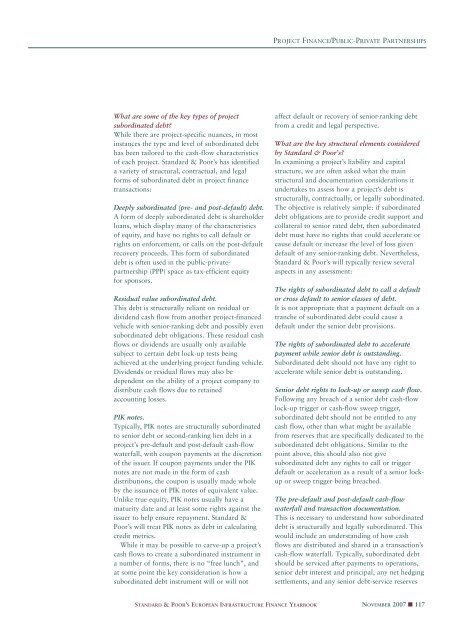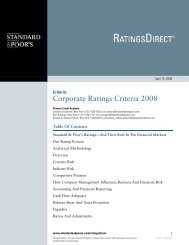European Infrastructure Finance Yearbook - Investing In Bonds ...
European Infrastructure Finance Yearbook - Investing In Bonds ...
European Infrastructure Finance Yearbook - Investing In Bonds ...
Create successful ePaper yourself
Turn your PDF publications into a flip-book with our unique Google optimized e-Paper software.
What are some of the key types of project<br />
subordinated debt?<br />
While there are project-specific nuances, in most<br />
instances the type and level of subordinated debt<br />
has been tailored to the cash-flow characteristics<br />
of each project. Standard & Poor’s has identified<br />
a variety of structural, contractual, and legal<br />
forms of subordinated debt in project finance<br />
transactions:<br />
Deeply subordinated (pre- and post-default) debt.<br />
A form of deeply subordinated debt is shareholder<br />
loans, which display many of the characteristics<br />
of equity, and have no rights to call default or<br />
rights on enforcement, or calls on the post-default<br />
recovery proceeds. This form of subordinated<br />
debt is often used in the public-privatepartnership<br />
(PPP) space as tax-efficient equity<br />
for sponsors.<br />
Residual value subordinated debt.<br />
This debt is structurally reliant on residual or<br />
dividend cash flow from another project-financed<br />
vehicle with senior-ranking debt and possibly even<br />
subordinated debt obligations. These residual cash<br />
flows or dividends are usually only available<br />
subject to certain debt lock-up tests being<br />
achieved at the underlying project funding vehicle.<br />
Dividends or residual flows may also be<br />
dependent on the ability of a project company to<br />
distribute cash flows due to retained<br />
accounting losses.<br />
PIK notes.<br />
Typically, PIK notes are structurally subordinated<br />
to senior debt or second-ranking lien debt in a<br />
project’s pre-default and post-default cash-flow<br />
waterfall, with coupon payments at the discretion<br />
of the issuer. If coupon payments under the PIK<br />
notes are not made in the form of cash<br />
distributions, the coupon is usually made whole<br />
by the issuance of PIK notes of equivalent value.<br />
Unlike true equity, PIK notes usually have a<br />
maturity date and at least some rights against the<br />
issuer to help ensure repayment. Standard &<br />
Poor’s will treat PIK notes as debt in calculating<br />
credit metrics.<br />
While it may be possible to carve-up a project’s<br />
cash flows to create a subordinated instrument in<br />
a number of forms, there is no “free lunch”, and<br />
at some point the key consideration is how a<br />
subordinated debt instrument will or will not<br />
STANDARD & POOR’S EUROPEAN INFRASTRUCTURE FINANCE YEARBOOK<br />
PROJECT FINANCE/PUBLIC-PRIVATE PARTNERSHIPS<br />
affect default or recovery of senior-ranking debt<br />
from a credit and legal perspective.<br />
What are the key structural elements considered<br />
by Standard & Poor’s?<br />
<strong>In</strong> examining a project’s liability and capital<br />
structure, we are often asked what the main<br />
structural and documentation considerations it<br />
undertakes to assess how a project’s debt is<br />
structurally, contractually, or legally subordinated.<br />
The objective is relatively simple: if subordinated<br />
debt obligations are to provide credit support and<br />
collateral to senior rated debt, then subordinated<br />
debt must have no rights that could accelerate or<br />
cause default or increase the level of loss given<br />
default of any senior-ranking debt. Nevertheless,<br />
Standard & Poor’s will typically review several<br />
aspects in any assessment:<br />
The rights of subordinated debt to call a default<br />
or cross default to senior classes of debt.<br />
It is not appropriate that a payment default on a<br />
tranche of subordinated debt could cause a<br />
default under the senior debt provisions.<br />
The rights of subordinated debt to accelerate<br />
payment while senior debt is outstanding.<br />
Subordinated debt should not have any right to<br />
accelerate while senior debt is outstanding.<br />
Senior debt rights to lock-up or sweep cash flow.<br />
Following any breach of a senior debt cash-flow<br />
lock-up trigger or cash-flow sweep trigger,<br />
subordinated debt should not be entitled to any<br />
cash flow, other than what might be available<br />
from reserves that are specifically dedicated to the<br />
subordinated debt obligations. Similar to the<br />
point above, this should also not give<br />
subordinated debt any rights to call or trigger<br />
default or acceleration as a result of a senior lockup<br />
or sweep trigger being breached.<br />
The pre-default and post-default cash-flow<br />
waterfall and transaction documentation.<br />
This is necessary to understand how subordinated<br />
debt is structurally and legally subordinated. This<br />
would include an understanding of how cash<br />
flows are distributed and shared in a transaction’s<br />
cash-flow waterfall. Typically, subordinated debt<br />
should be serviced after payments to operations,<br />
senior debt interest and principal, any net hedging<br />
settlements, and any senior debt-service reserves<br />
NOVEMBER 2007 ■ 117



